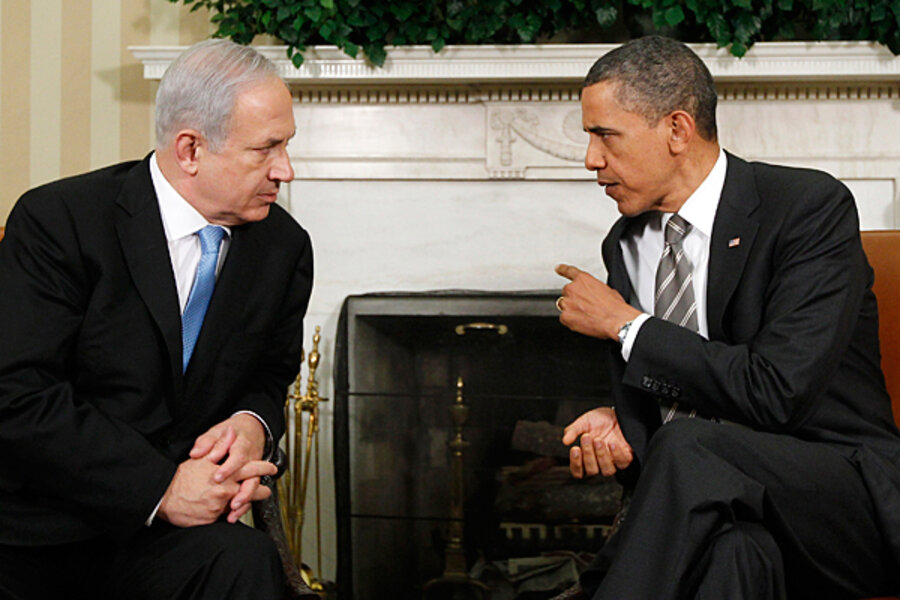Netanyahu and Obama meet: harmonious picture, blunt disagreement
Loading...
| Washington
President Obama and Israeli Prime Minister Benjamin Netanyahu sought Friday to smooth over the tensions that burst open a day earlier as a result of new ground Mr. Obama staked out for Israeli-Palestinian peace.
Despite the harmonious picture the two leaders offered in a joint media appearance at the White House, neither side claimed that deep differences were surmounted in what Obama called a “prolonged and extremely useful conversation.”
Mr. Netanyahu quickly rejected the US president’s endorsement – made during his Middle East speech at the State Department on Thursday – of starting with Israel’s pre-1967 borders as the basis for negotiating final territory lines with the Palestinians.
Israel “cannot go back to the 1967 lines,” the Israeli leader said. “Those lines are indefensible.”
US administrations and other international powers have referred for decades to the 1967 lines as the starting point for negotiations on final borders, but Obama was the first American president to make the idea of the ’67 borders as a basis for negotiations an official US policy.
Behind the scenes, Israeli officials expressed anger that Obama has now set as a starting point for territory negotiations a position the Israelis had hoped to use as a bargaining chip with the Palestinians. On the White House side, US officials are frustrated that Obama’s proposal for getting to permanent-status talks by starting with territory and security – widely viewed as the more tractable of the issues separating the two sides – is being characterized in some quarters as a significant leap beyond established US policy.
“Articulating a … truth is not some radical new departure from where we’ve been,” said White House spokesman Jay Carney, in a briefing following the two leaders’ meeting. “There is no carrot here” for the Palestinians, as some have charged, he added. By speaking Thursday of the 1967 borders “with mutually agreed swaps,” Obama was recognizing “what all sides agree is the starting point for talks,” Mr. Carney said.
In reviewing his longer-than-anticipated discussion with Netanyahu, Obama said both leaders agreed that “this is an opportunity that can be seized” in the Middle East. He added that both recognized the “significant perils as well.”
Among the perils Obama cited is Iran, which sits near the top of Netanyahu’s list of enemies of the Jewish state. Obama said the two discussed the “hypocrisy” of Iranian officials lauding the Arab pro-democracy movements even as Iran violently represses forces for political change at home.
While the two leaders appeared to be largely in-tune on Iran, they diverged in their approaches to Hamas, the radical Palestinian organization that has just reached a political accord with the Fatah party in power in the West Bank.
Obama, as he had in his speech the day before, said the Palestinians have “very difficult questions to answer about the agreement between Fatah and Hamas.” Saying Hamas as it presents itself “is not a partner for a … peace process,” the president said Palestinians “will have to explain” how they expect to proceed with peace talks even as they plan to share governing with a group that officially rejects Israel’s right to exist.
Netanyahu was more categorical still, saying Israel would never sit down with any Palestinian government that includes the extremist Islamists. “Israel cannot negotiate with a Palestinian government that is backed by Hamas,” he said, before concluding that the organization ruling the Gaza Strip is “the Palestinian version of Al Qaeda.”
Both Obama and Netanyahu will address the pro-Israel American Israel Public Affairs Committee (AIPAC) annual conference in Washington Sunday. Netanyahu then speaks Tuesday to a joint session of Congress.
Despite the hearty handshakes and public rift-repairing, the two leaders nevertheless demonstrated differing perceptions of the tumult in the Middle East. While Obama preferred to refer to a time of “opportunity,” Netanyahu said he would not permit a “time of extraordinary instability in the Middle East” to “jeopardize Israel’s survival.”
On the other end of the spectrum from AIPAC, other groups calling themselves both “pro-Israel” and “pro-peace” – like the J Street organization – are promoting the idea that the real “existential threat” to Israel’s survival is resistance like Netanyahu’s to moving forward on a two-state solution.
The next few days are likely to demonstrate to Netanyahu whether either of these two visions resonates today in America.





